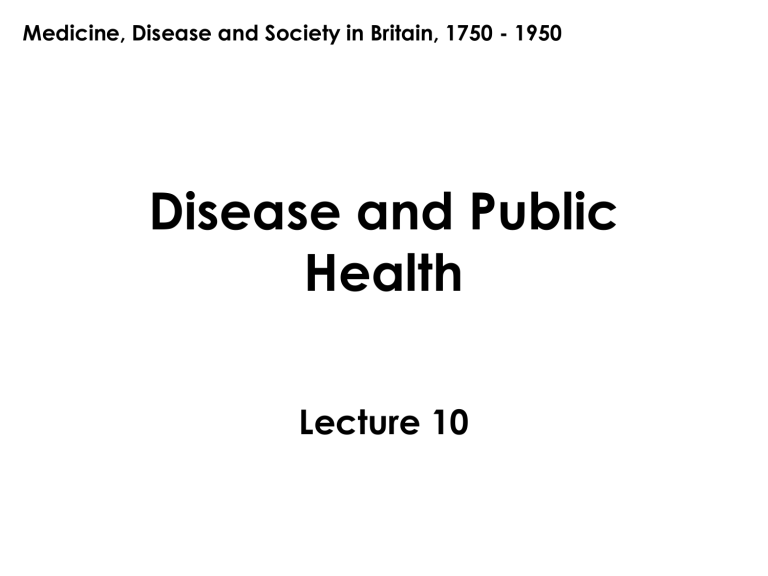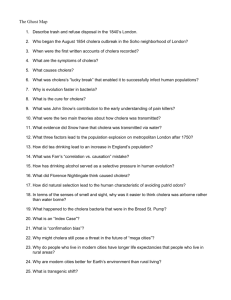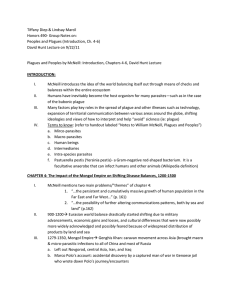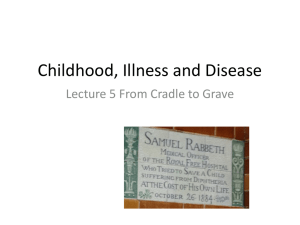Disease and Public Health

Medicine, Disease and Society in Britain, 1750 - 1950
Disease and Public
Health
Lecture 10
Lecture Themes and Outline
• Disease, mortality and demography
– McKeown thesis
– More recent interpretations
• Three diseases prevalent in c18th and c19th demonstrating varying degrees of state intervention with varying degrees of success (though also many more e.g. measles, typhus, influenza, typhoid)
– Smallpox – inoculation, vaccination, protests
– TB/phthisis – nutrition vs state intervention
– Cholera – widespread public health reforms, sanitation
Disease, mortality and demography
• Epidemic = prevalent in waves, shortterm; attacks populations indiscriminately.
• Endemic = regularly or usually found among the population.
• Pandemic = global outbreak of disease in limited time period.
• 1836 Registration Act – compulsory for births and deaths to be registered.
McKeown thesis
• Challenged the assumption that improvements in medicine directly accounted for population growth – aside from vaccination
• Falling death rates from disease, particularly childhood disease, were due to better nutrition and living standards and public health rather than immunisation.
• Work responded to by Simon Szreter and
Anne Hardy
Smallpox
Smallpox
• Smallpox endemic and epidemic – only arena where significant decline in death rates due to direct medical intervention up until late c19th.
• Inoculation – Lady Mary Wortley
Montague (1720 son inoculated in
Constantinople
• Vaccination – Dr Edward Jenner, 1790s
Edward Jenner (1749-1823)
Vaccination developed in 1796.
Observed that milkmaids and stockmen rarely developed smallpox.
Inoculated James Phipps with cowpox and
6 weeks later with smallpox – proved immunity to smallpox.
Pamphlet An Inquiry into the Causes and
Effects of Variola Vaccinae (1798)
Jenner vaccinating James Phipps
Cartoon by James Gillray: Vaccination against
Smallpox using Cowpox serum, 1802, engraving-hand colour
Tuberculosis
• Major killer in the C19th.
• 1839 TB was responsible for 17.6% of all deaths in England and Wales.
• In the early C20th it remained the most prominent chronic illness – 75,000 deaths per year.
• Spread through close personal contact – important to remove sufferers from their environment.
c. 1930
Cholera Outbreaks
• 1826 – second global pandemic, travelled from Asia
• 1831-2 - first hits Britain
• 1848-9 – second British epidemic
• 1853-4
• 1865-6
Blue stage of girl who died from cholera in
Sunderland, 1832
Thomas Shapter, The History of the
Cholera in Exeter (1832)
The inadequate water supply combined with the deficiency of drainage, is of itself sufficient evidence, that the necessary accommodation for the daily usages of the population must have been very limited... they speak of dwellings occupied by from five to fifteen families huddled together in dirty rooms with every offensive accompaniment; slaughter-houses in the
Butcher Row, with their putrid heaps of offal; of pigs in large numbers kept throughout the city...poultry kept in confined cellars and outhouses; of dung heaps everywhere
Cholera Map of Exeter, 1832
Map of Bethnal Green showing the ‘cholera mist’
1848-9
Water supply Bethnal Green
Lodging Houses
Cholera deaths in England 1849
Edwin Chadwick (1800-1890)
1842, Report on the Sanitary
Condition of the Working
Population of Great Britain.
Emphasised the need for experts to be employed by government and believed the role of the state should be regulatory rather than directive.
His report cited disease as a major cause of poverty – reduced earning capacity of the working classes.
• j
John Snow (1813-1858)
1855 ‘On the Mode of
Communication of
Cholera’.
Argued that cholera was ‘water-borne’ and not just based on miasmas and insanitary conditions.
Snow’s map of Broad Street
Soho district in London.
Called the ‘cholera field’ by Snow.
Over 500 people died in 10 days from 1 to 10
September 1854. Snow linked the deaths to the source of water.
‘King Cholera’
Monster Soup: Thames Water
Public Health Legislation
• 1848 Public Health Act
• 1855,1860 and 1863 Nuisance Removal
Acts
• 1866 Sanitary Act
• 1872 Public Health Act
• 1875 Public Health Act
• 1889 Infectious Diseases Notification
Act
Conclusion
• Actions against epidemics greatly reduced the numbers of deaths from diseases such as cholera and smallpox.
• Sanitary reform saved lives and improved living conditions.
• Public health reform was delivered unevenly across the population – poorer classes often last to receive it.
• Implementation of reform was affected by the concerns of central and local government – financial, social and legal.









